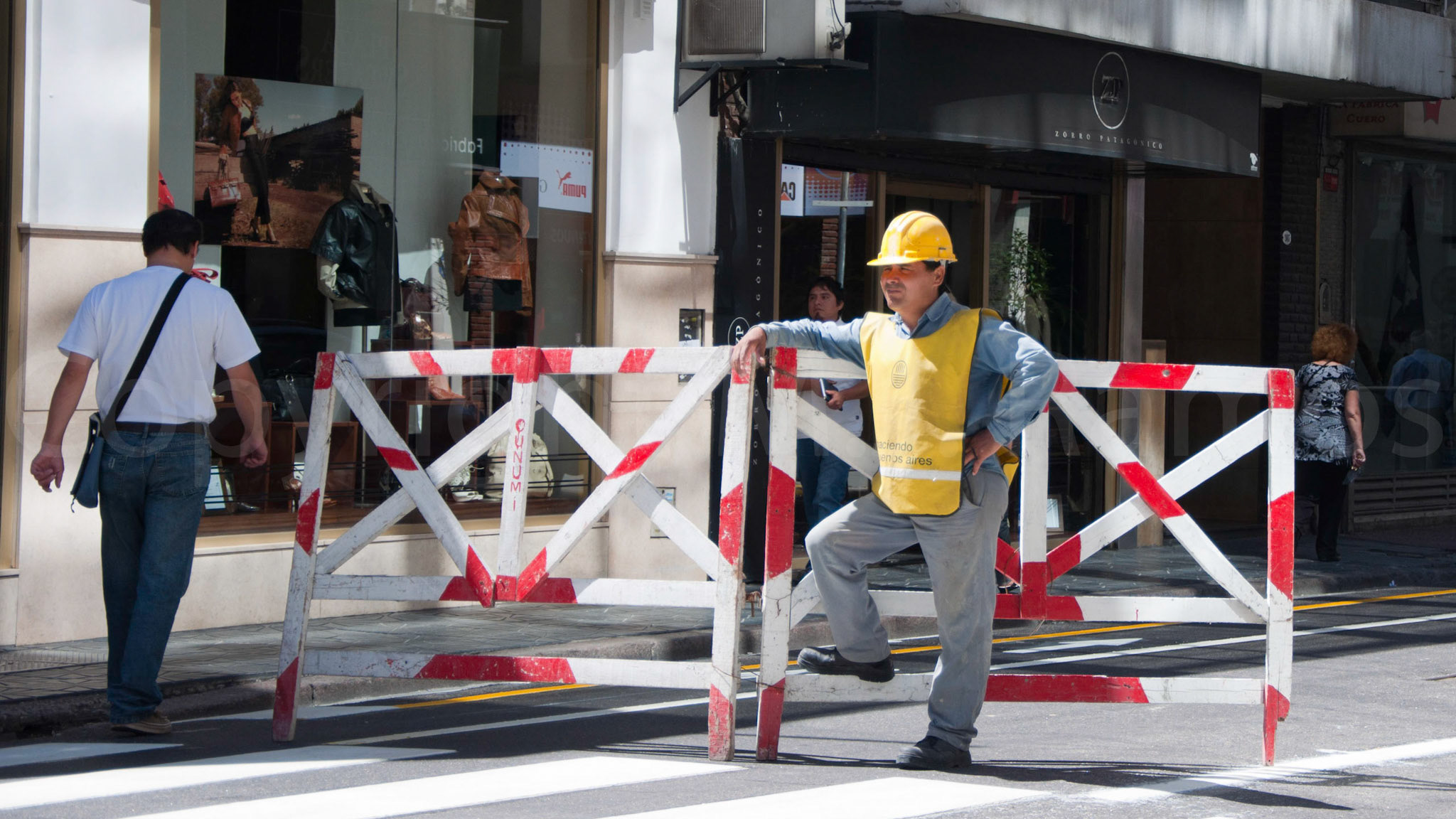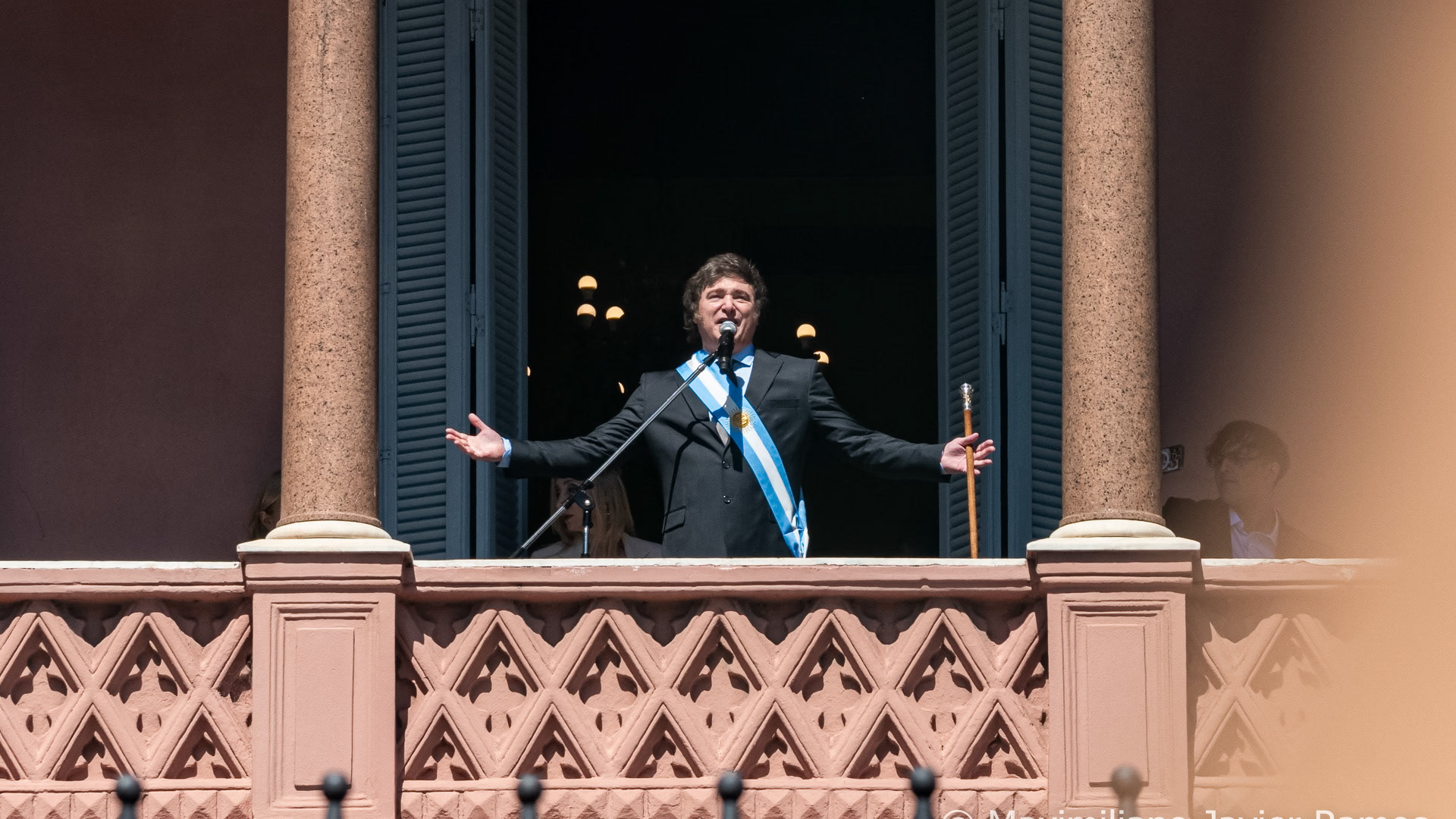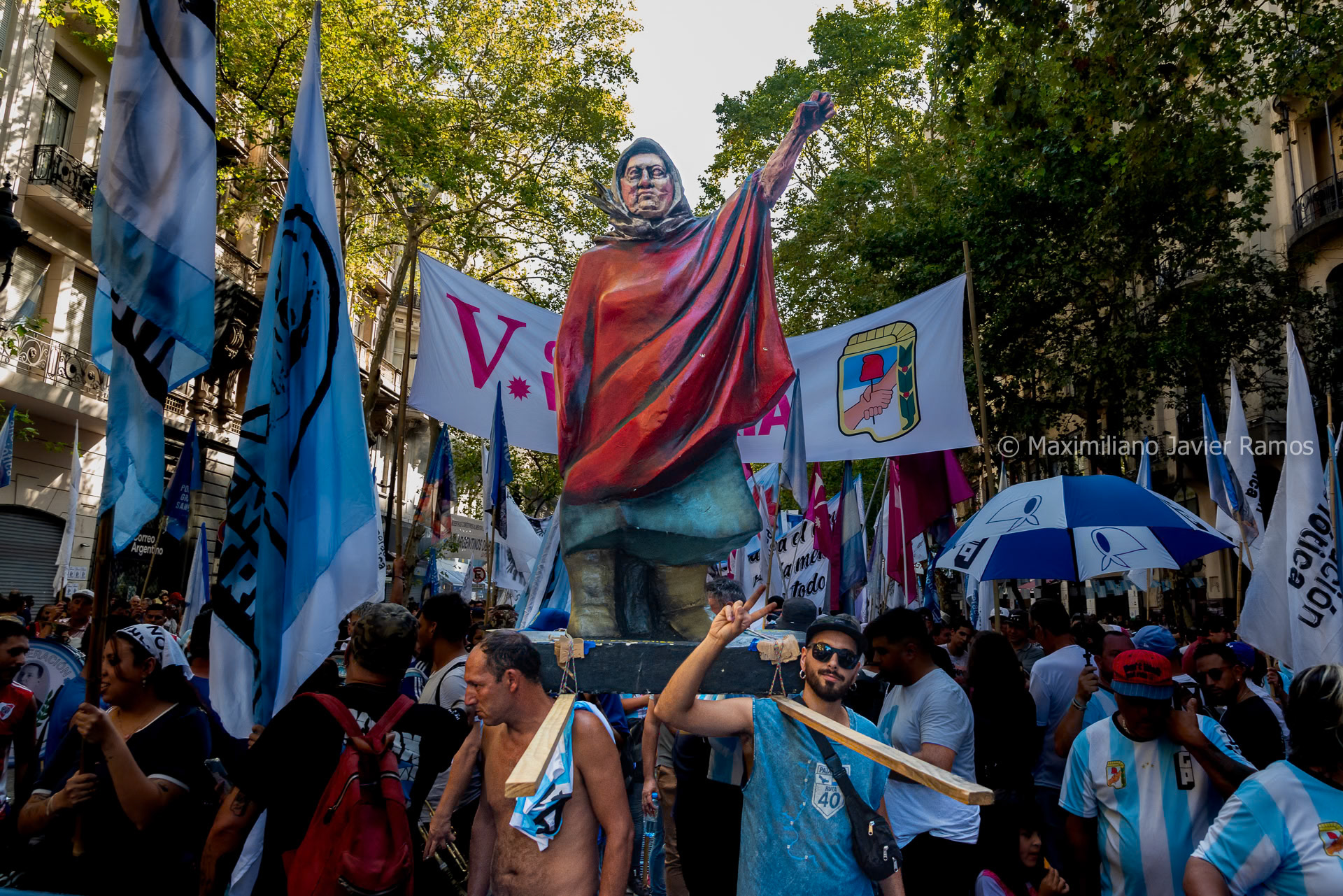
Un grupo de manifestantes que llevan una estatua de Hebe de Bonafini, una de las fundadoras de "Madres de Plaza de Mayo".A group of demonstrators carrying a statue of Hebe de Bonafini, one of the founders of "Madres de Plaza de Mayo".

Rostro de una mujer que lleva un aro en su oreja con la forma del pañuelo característico de “Abuelas de Plaza de Mayo” durante la manifestación de hoy.Face of a woman who wears a ring on her ear with the shape of the handkerchief characteristic of "Grandmothers of Plaza de Mayo" during today's demonstration.
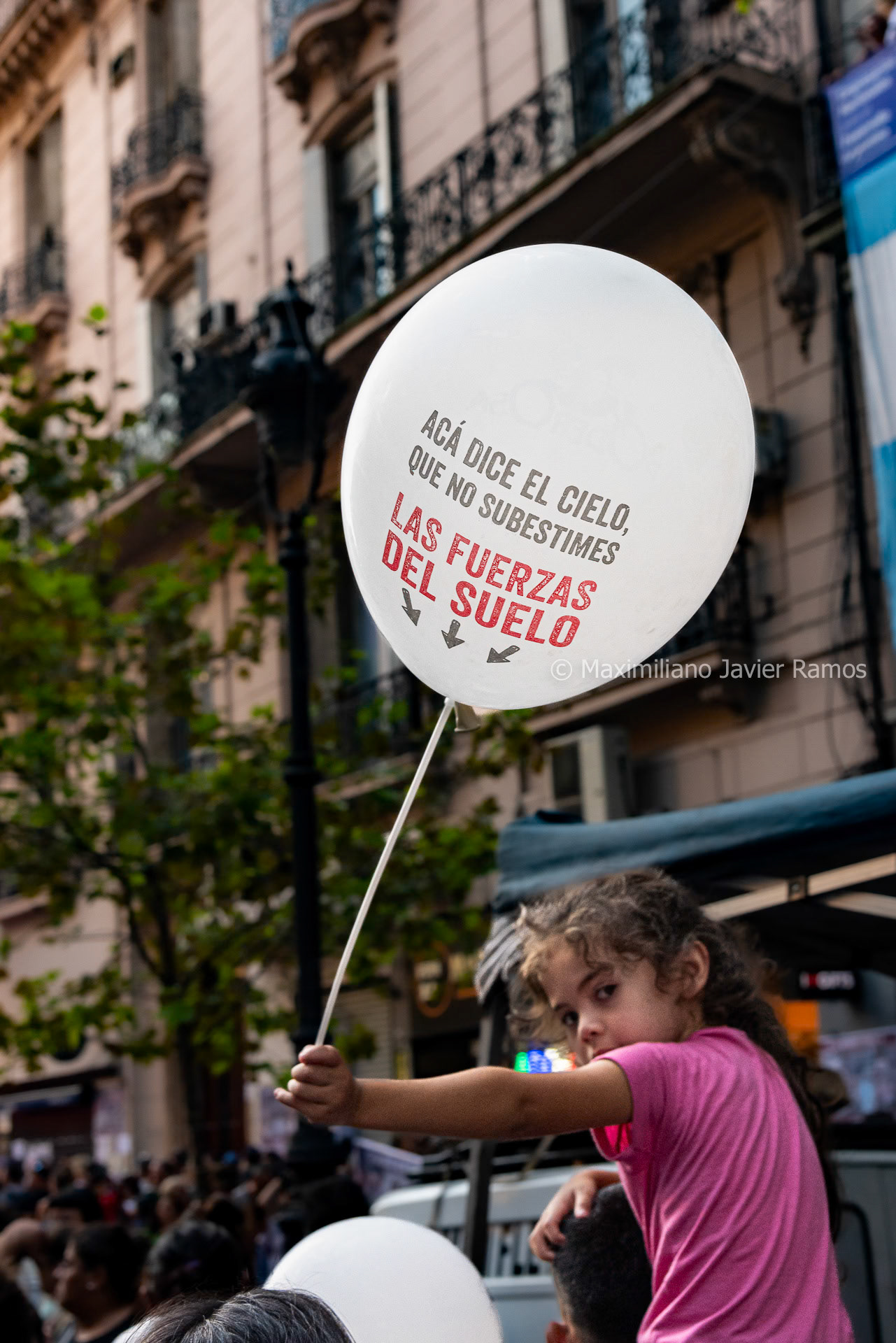
Una niña lleva un globo que dice “Acá dice el cielo que no subestimes las fuerzas del suelo” en referencia a el slogan del Presidente Javier Milei “Las fuerzas del cielo”.A girl carries a balloon that says "Here the sky says that you don't underestimate the forces of the ground" in reference to President Javier Milei's slogan "The forces of heaven."

Varios manifestantes caminando y de fondo un pañuelo que dice “Son 30.000” cuelga de una ventana en referencia a los 30.000 desaparecidos durante la última dictadura militar en Argentina.Several protesters walking and in the background a handkerchief that says "They are 30,000" hangs from a window in reference to the 30,000 disappeared during the last military dictatorship in Argentina.
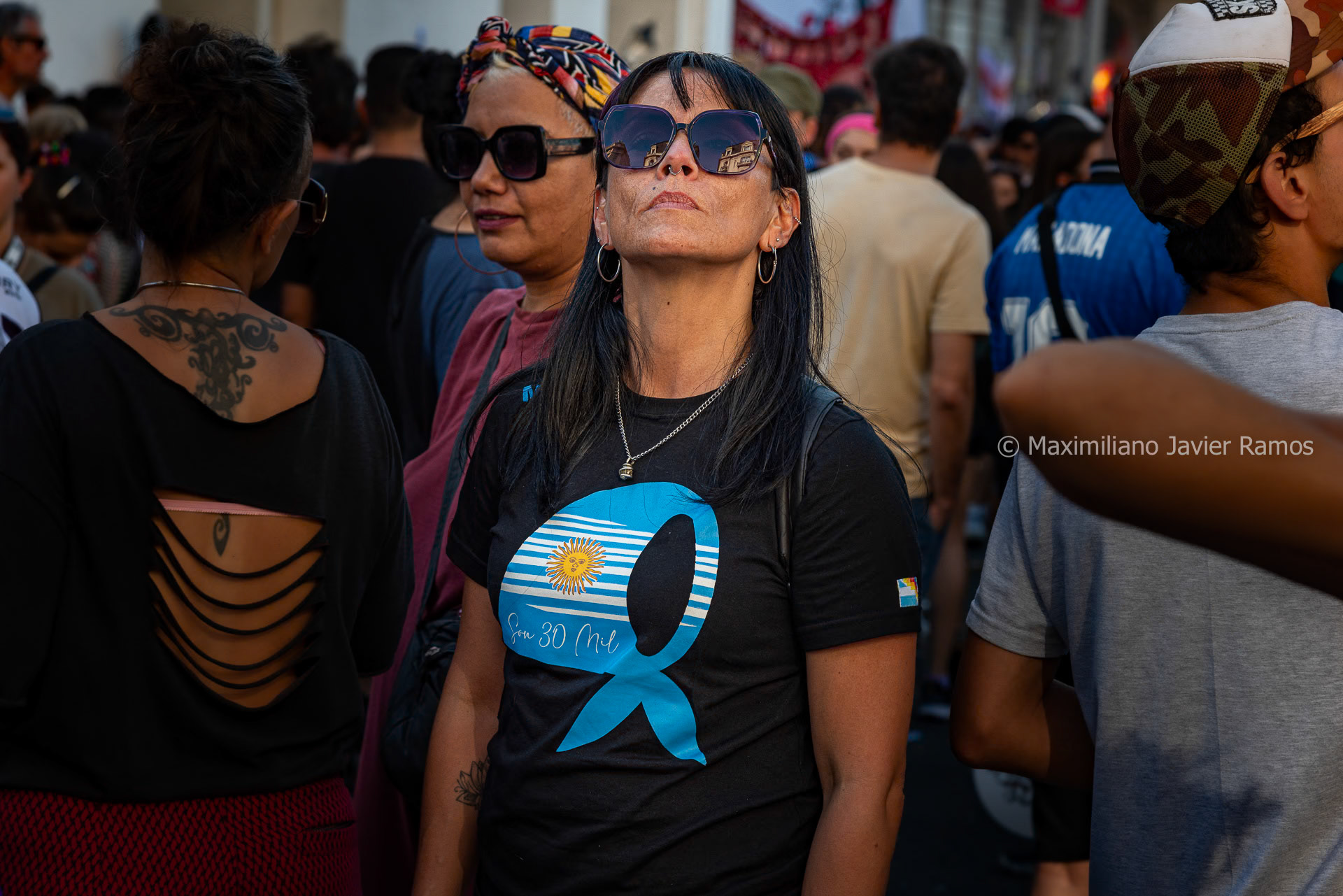
Una mujer mira hacia el cielo a través de sus anteojos oscuros en medio de la muchedumbre, lleva una remera con el pañuelo de las Abuelas de Plaza de Mayo con los colores de la bandera Argentina y la frase “Son 30 mil” en referencia a los 30.000 desaparecidos durante la última dictadura militar en Argentina.A woman looks up at the sky through her dark glasses in the middle of the crowd, wears a t-shirt with the handkerchief of the Grandmothers of Plaza de Mayo with the colors of the Argentine flag and the phrase "There are 30,000 thousand" in reference to the 30,000 disappeared during the last military dictatorship in Argentina.
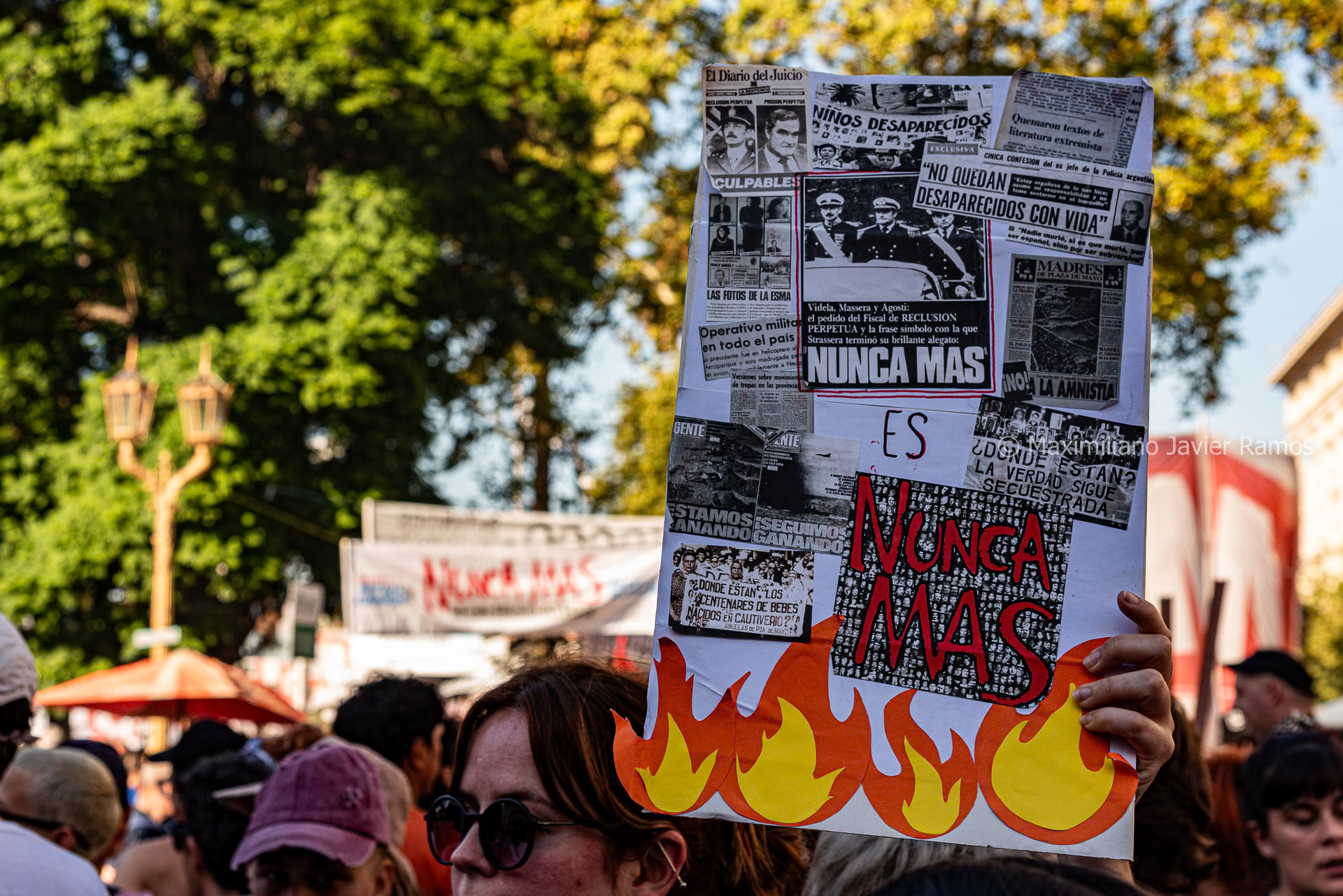
Sobre el fondo difuminado de la manifestación en Plaza de Mayo una mujer sostiene una pancarta con recortes de periódicos donde se destacan los titulares sobre desaparecidos durante la última dictadura militar en Argentina. Se lee claramente la frase “Nunca más es nunca mas” y unas llamas dibujadas debajo.On the blurred background of the demonstration in Plaza de Mayo, a woman holds a banner with newspaper clippings highlighting the headlines about disappeared during the last military dictatorship in Argentina. The phrase "Never again is never again" and some flames drawn underneath are clearly read.
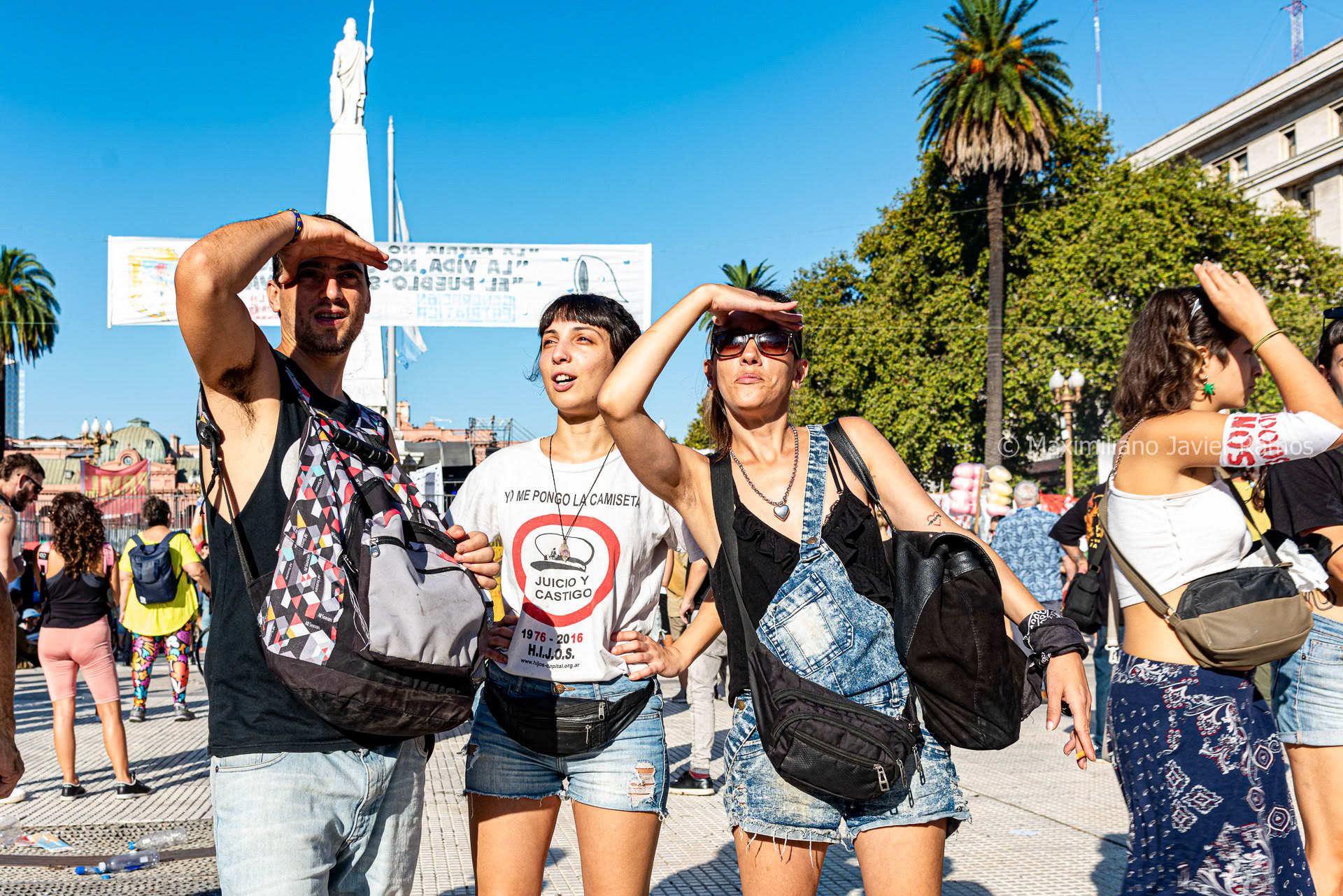
En una soleada Plaza de Mayo se ven tres jóvenes manifestantes, la mujer en el centro lleva una remera que dice “Yo me pongo la camiseta. Juicio y Castigo” sobre el dibujo de in gorro militar en clara referencia a la Junta Militar que gobernó durante el proceso militar. In a sunny Plaza de Mayo you can see three young demonstrators, the woman in the center is wearing a t-shirt that says "I put on my shirt. Judgment and Punishment" on the drawing of military hat in clear reference to the Military Junta that ruled during the military process.
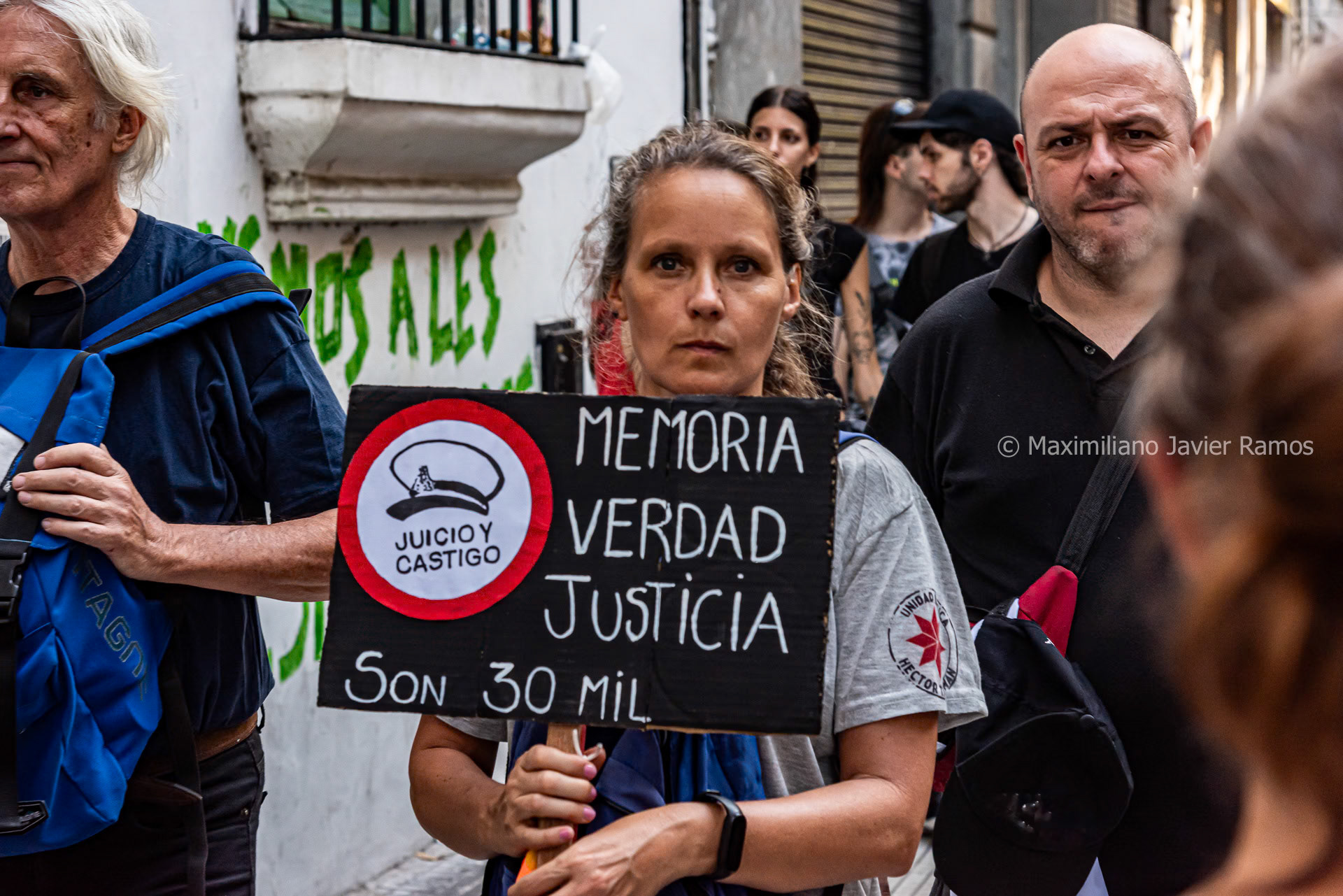
Una mujer lleva un cartel donde se lee “Juicio y Castigo” sobre el dibujo de in gorro militar en clara referencia a la Junta Militar que gobernó durante el proceso militar junto a las palabras “Memoria, Verdad y Justicia. Son 30 mil”.A woman carries a sign that reads "Judge and Punishment" on the drawing of a military cap in clear reference to the Military Junta that ruled during the military process along with the words "Memory, Truth and Justice. It's 30 thousand."
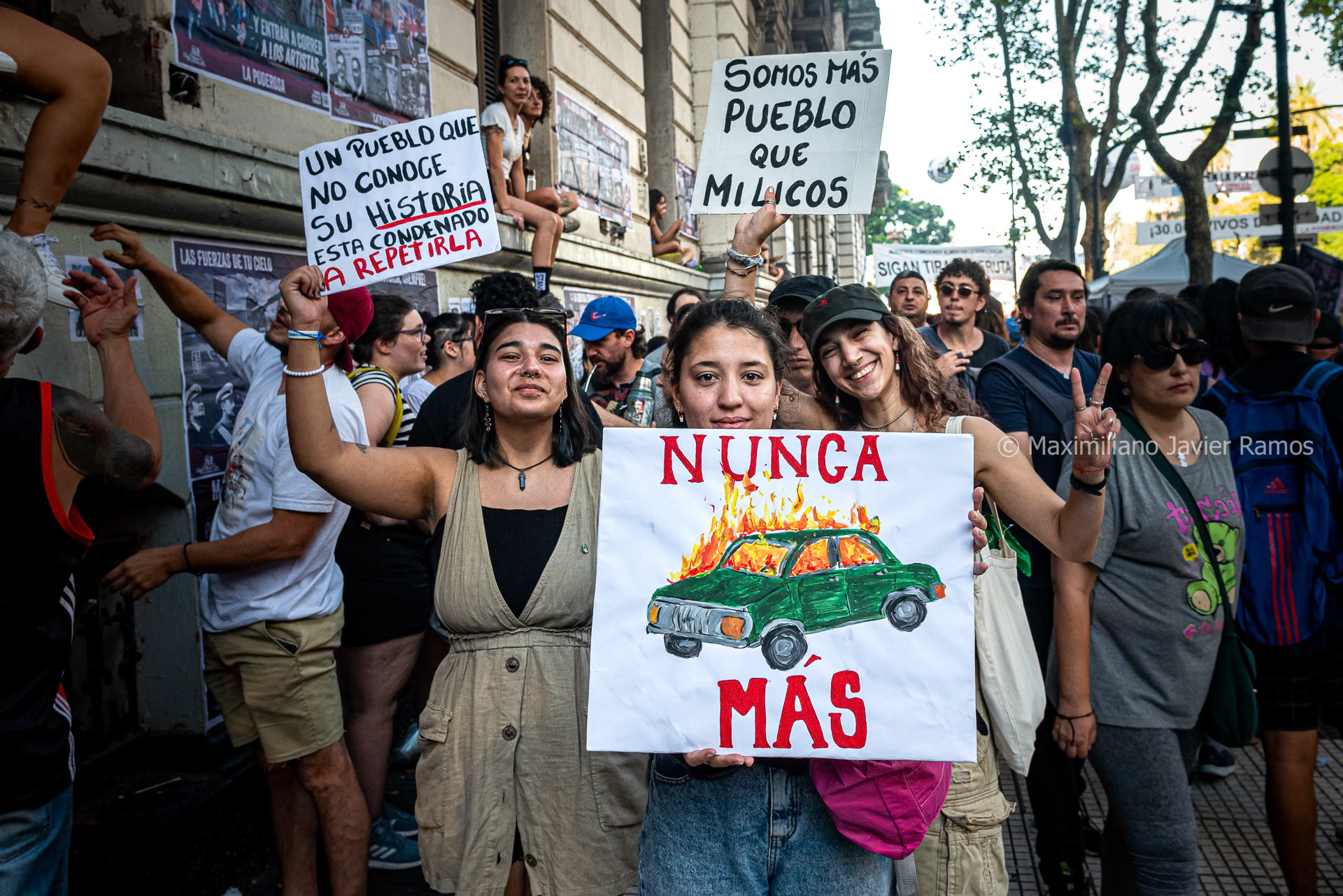
Caminando junto al gentío tres mujeres jóvenes llevan carteles donde se lee: “Un Pueblo que no conoce su historia está condenado a repetirla”, “Somos más pueblo que Milicos” y “Nunca Más” junto al dibujo de un Ford Falcon Verde en llamas, auto utilizado en los secuestros clandestinos llevados a cabo durante la última dictadura militar en Argentina.Walking next to the crowd, three young women carry posters that read: "A People who do not know their history is condemned to repeat it," "We are more people than Milicos (military)” and "Never More" along with the drawing of a Ford Falcon Verde in flames, a car used in the clandestine kidnappings carried out during the last military dictatorship in Argentina.
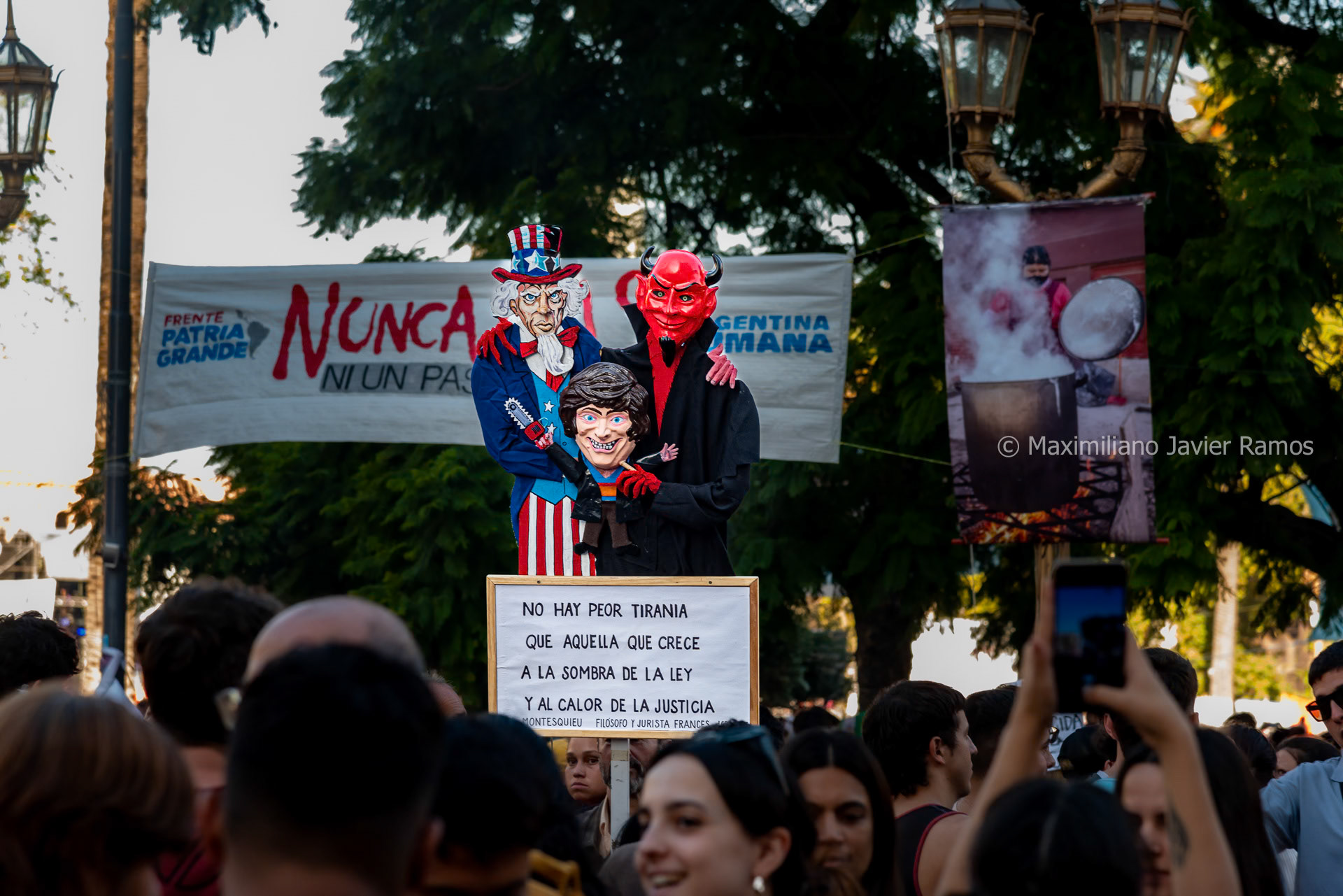
Rodeado por otros manifestantes en Plaza de Mayo, un hombre sostiene un cartel donde se ve al “Tío Sam” y al diablo apoyando sus manos sobre los hombros del Presidente de Argentina Javier Milei. Debajo se lee la frase de Montesquieu: “No hay peor tiranía que la que crece a al sombra de la ley y al calor de la justicia”Surrounded by other demonstrators in Plaza de Mayo, a man holds a sign where "Tío Sam" and the devil are seen resting his hands on the shoulders of the President of Argentina Javier Milei. Below is Montesquieu's phrase: "There is no worse tyranny than the one that grows in the shadow of the law and in the heat of justice"

Caminando por las calles de Buenos Aires con el Obelisco de fondo, se ve de espaldas a tres miembros de una familia con remeras que dicen “Memoria, Verdad y Justicia”Walking through the streets of Buenos Aires with the Obelisk in the background, you can see three members of a family with t-shirts that say "Memory, Truth and Justice"
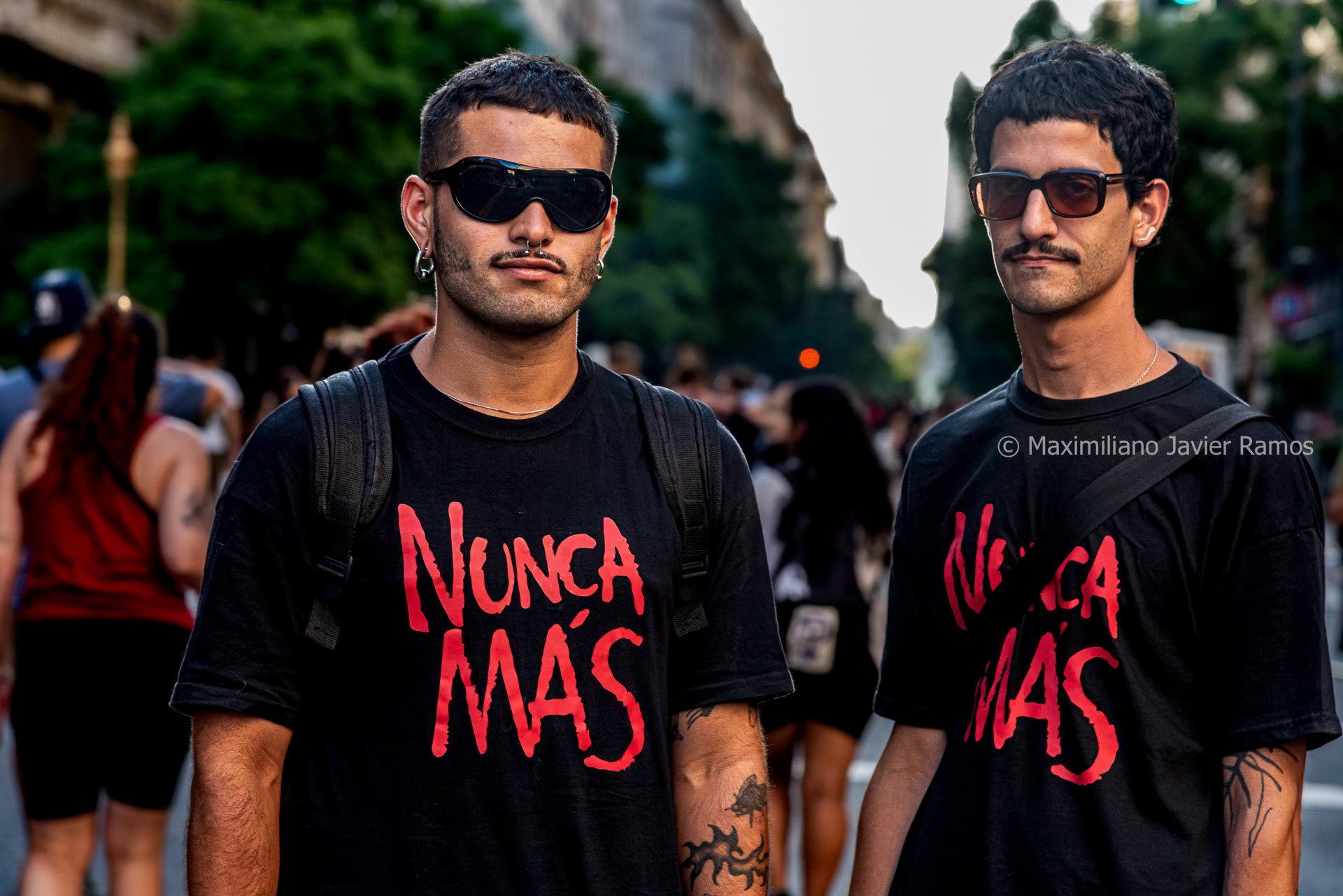
Dos varones jóvenes, vestidos completamente de negro y con anteojos oscuros, llevan puestas sus remeras con la frase “Nunca Más” escrita en rojo.Two young men, dressed completely in black and with dark glasses, wear their t-shirts with the phrase "Never Again" written in red.
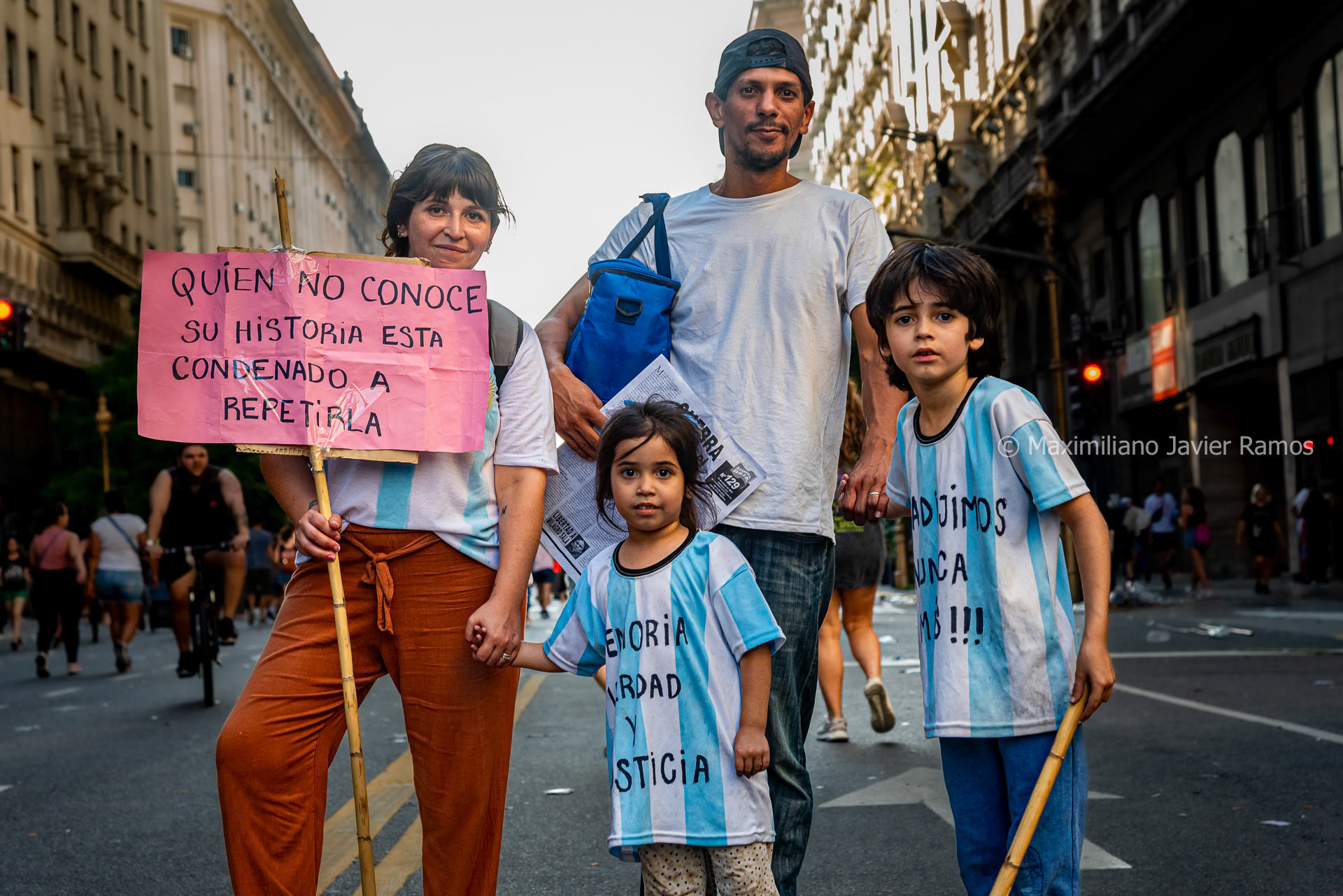
Una familia se dirige a la manifestación en Plaza de Mayo. La madre sostiene un cartel con la frase “Quien no conoce su historia está condenado a repetirla” escrita, los niños con remeras argentinas y las frases “Memoria, Verdad y Justicia” y “Ya dijimos Nunca más” miran a cámara junto a su padre, tomados de las manos. A family is heading to the demonstration in Plaza de Mayo. The mother holds a banner with the phrase "Who does not know his story is condemned to repeat it" written, the children with Argentine t-shirts and the phrases "Memory, Truth and Justice" and "We said never again" look at the camera next to their father, holding hands.
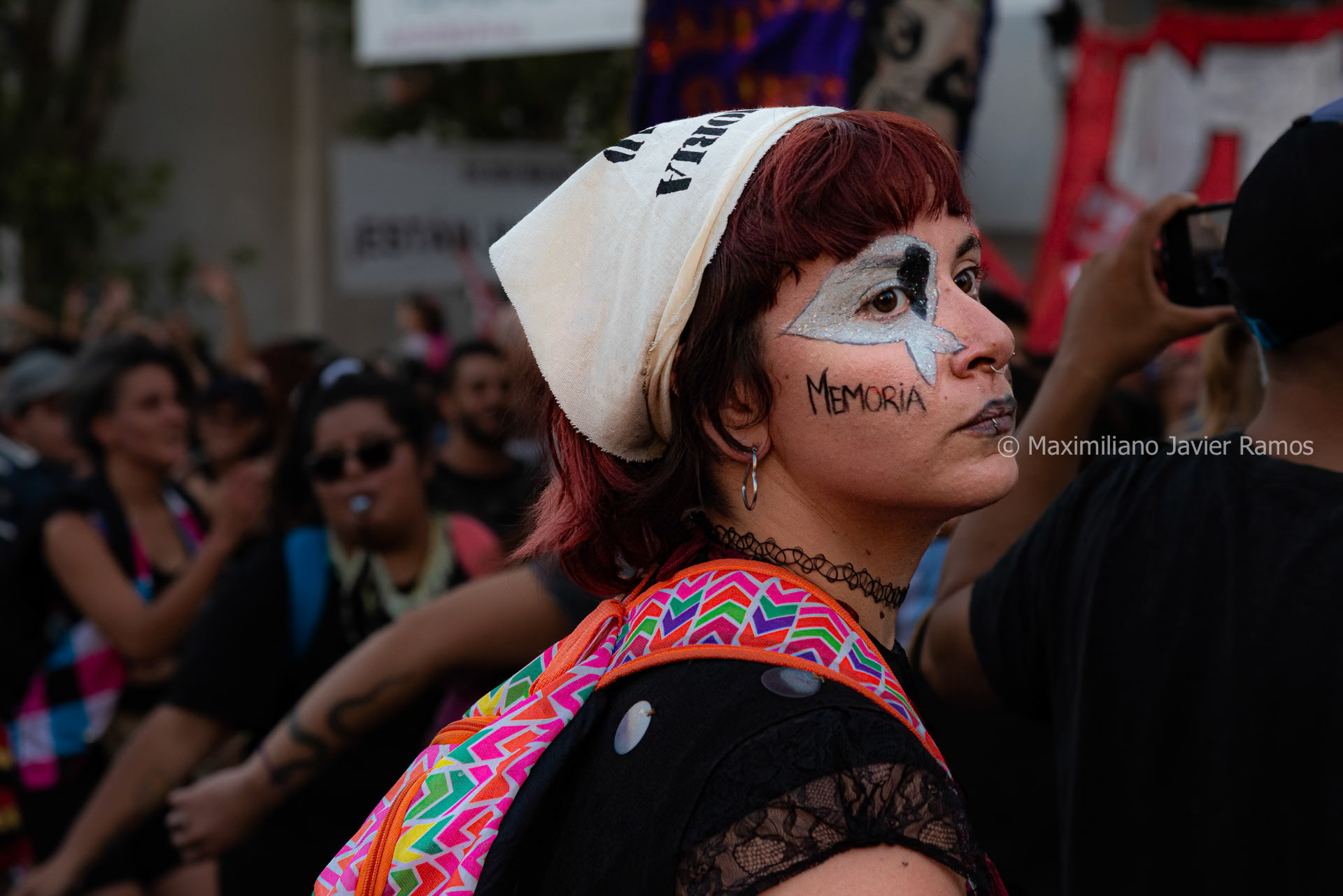
Primer plano de una mujer joven con un pañuelo blanco (símbolo de Madres y Abuelas de Plaza de Mayo.) pintado en la cara junto a la palabra “Memoria”Close-up of a young woman with a white handkerchief (symbol of Mothers and Grandmothers of Plaza de Mayo.) painted on her face next to the word "Memory"
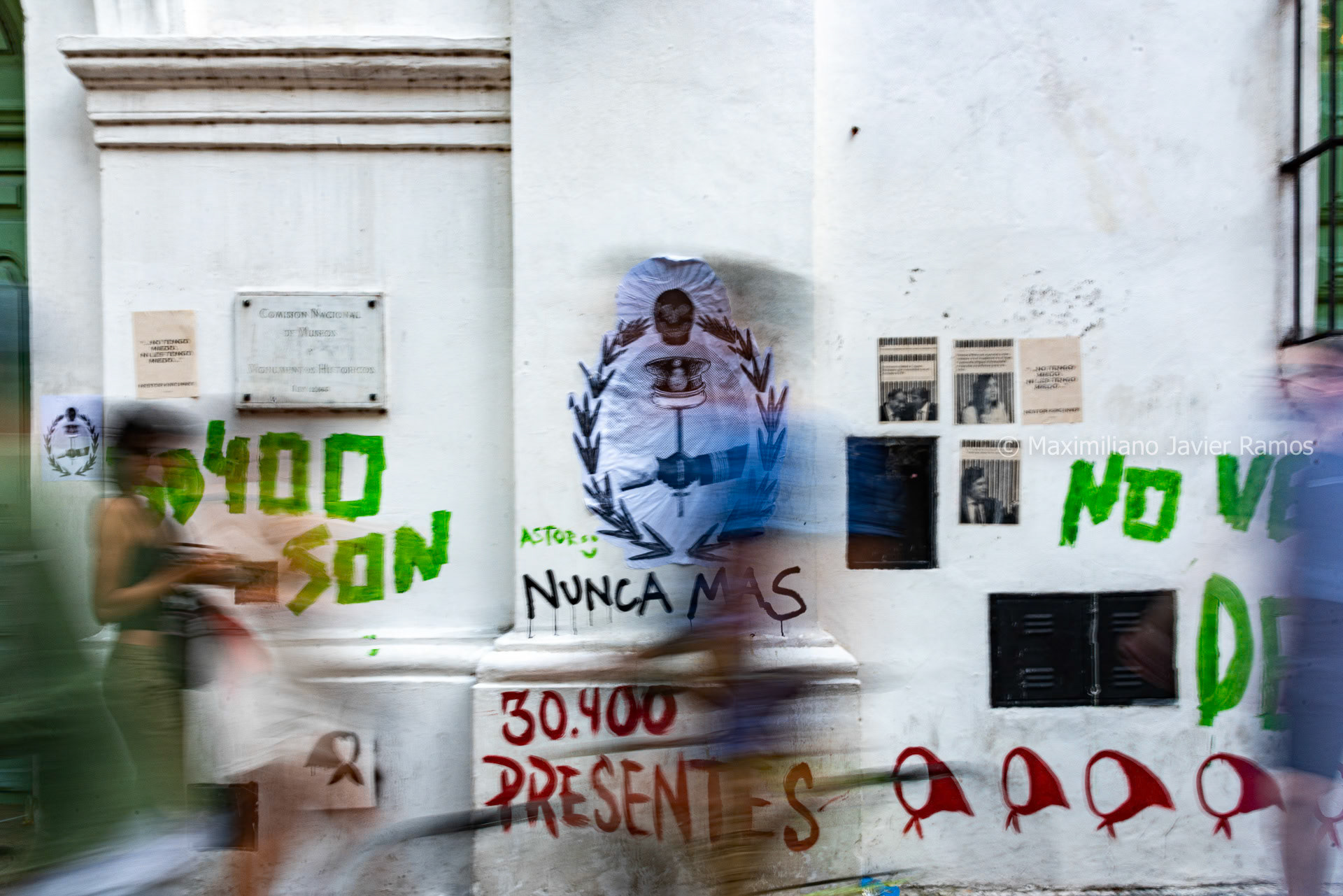
Varios manifestantes se desplazan como fantasmas delante de una pared pintada en las cercanías de Plaza de Mayo. En el muro se puede leer: “Nunca Más”, “Son 30.400” en referencia a los desaparecidos de la comunidad LGBT+ junto a fotos del presidente Javier Milei, la vicepresidente Victoria Villarruel y el Escudo Nacional Argentino conformado por una calavera, una corona de balas, una gorra militar y las manos de un militar y un civil que se estrechan y a la vez sostienen un crucifijo. Several protesters move like ghosts in front of a painted wall in the vicinity of Plaza de Mayo. On the wall you can read: "Never More", "It's 30,400" in reference to the disappeared from the LGBT+ community along with photos of President Javier Milei, Vice President Victoria Villarruel and the Argentine National Shield made up of a skull, a crown of bullets, a military cap and the hands of a military chief and a civilian who shake and at the same time hold a crucifix.
24 de marzo de 2024: Argentina conmemora el Día de la Memoria en honor a las víctimas del terrorismo de Estado.
En el 46° aniversario del golpe militar de 1976, Argentina se detiene para recordar y reflexionar sobre uno de los capítulos más oscuros de su historia, honrando a los desaparecidos y reafirmando su compromiso con la verdad, la justicia y la memoria.
El 24 de marzo de cada año en Argentina es un día de profundo significado y reflexión. Es el Día de la Memoria por la Verdad y la Justicia, una fecha que marca el aniversario del golpe militar de 1976, que dio inicio a un período de terrorismo de Estado en el país sudamericano. Este día es un momento para recordar a las miles de personas que fueron víctimas de desaparición forzada, tortura y asesinato durante la dictadura militar.
La memoria es fundamental para comprender y aprender de los errores del pasado, y en Argentina, el Día de la Memoria es una ocasión para rendir homenaje a aquellos que perdieron sus vidas luchando por la justicia y la libertad. Es también un recordatorio de la importancia de defender los derechos humanos y de trabajar constantemente para garantizar que los crímenes del pasado nunca se repitan.
En el 46° aniversario del golpe militar, se realizaron diversos actos conmemorativos en todo el país, incluyendo marchas, ceremonias y actividades culturales. Las organizaciones de derechos humanos y los familiares de las víctimas continúan exigiendo verdad y justicia, luchando incansablemente para identificar y juzgar a los responsables de los crímenes de lesa humanidad cometidos durante la dictadura.
El Día de la Memoria no solo es un día de duelo, sino también un día de acción y compromiso. Es un llamado a mantener viva la memoria histórica, a seguir buscando la verdad y a trabajar por una sociedad más justa y democrática. En un contexto mundial donde los derechos humanos siguen siendo vulnerados, la conmemoración de este día cobra una relevancia aún mayor, recordándonos la importancia de defender los valores de la verdad, la justicia y la memoria.
March 24, 2024: Argentina commemorates Remembrance Day in honor of the victims of state terrorism.
On the 46th anniversary of the 1976 military coup, Argentina pauses to remember and reflect on one of the darkest chapters in its history, honoring the disappeared and reaffirming its commitment to truth, justice and memory.
March 24 of each year in Argentina is a day of deep meaning and reflection. It is the Day of Remembrance for Truth and Justice, a date that marks the anniversary of the 1976 military coup, which began a period of state terrorism in the South American country. This day is a moment to remember the thousands of people who were victims of forced disappearance, torture and murder during the military dictatorship.
Memory is essential to understanding and learning from the mistakes of the past, and in Argentina, Remembrance Day is an occasion to pay tribute to those who lost their lives fighting for justice and freedom. It is also a reminder of the importance of upholding human rights and constantly working to ensure that the crimes of the past are never repeated.
On the 46th anniversary of the military coup, various commemorative events were held throughout the country, including marches, ceremonies and cultural activities. Human rights organizations and victims' families continue to demand truth and justice, fighting tirelessly to identify and prosecute those responsible for crimes against humanity committed during the dictatorship.
Remembrance Day is not only a day of mourning, but also a day of action and commitment. It is a call to keep historical memory alive, to continue seeking the truth and to work for a more just and democratic society. In a global context where human rights continue to be violated, the commemoration of this day takes on even greater relevance, reminding us of the importance of defending the values of truth, justice and memory.





